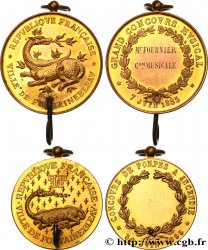E-auction 304-223228 - fme_371839 - III REPUBLIC Médaille agricole
You must signin and be an approved bidder to bid, LOGIN TO BID. Accounts are subject to approval and the approval process takes place within 48 hours. Do not wait until the day a sale closes to register. Clicking on « bid » constitutes acceptance of the terms of use of cgb.fr private e-auctions.
Bids must be placed in whole Euro amounts only. The sale will start closing at the time stated on the item description; any bids received at the site after the closing time will not be executed. Transmission times may vary and bids could be rejected if you wait until the last second. For further information ckeck the E-auctions F.A.Q.
NO BUYER'S FEE.
NO BUYER'S FEE.
| Estimate : | 120 € |
| Price : | 22 € |
| Maximum bid : | 25 € |
| End of the sale : | 11 February 2019 18:24:00 |
| bidders : | 5 bidders |
Type : Médaille agricole
Date: n.d.
Mint name / Town : France
Metal : silver
Diameter : 45,5 mm
Orientation dies : 12 h.
Engraver VAUTHIER-GALLÉ André (1818-1899)
Weight : 50 g.
Edge : lisse + corne ARGENT
Coments on the condition:
Médaille d’aspect brossé, avec des taches de rouille. Nettoyage un peu agressif
Obverse
Obverse legend : RÉPUBLIQUE FRANÇAISE.
Obverse description : Tête laurée de Cérés à gauche, la chevelure en chignon avec blé, feuilles de chêne et de laurier.
Reverse
Reverse legend : ANÉPIGRAPHE.
Reverse description : Couronne circulaire mêlant des gerbes de blé, de la vigne, un coq et des têtes de bélier, boeuf, cheval et porc.
Commentary
Tête de Cérès dans le style de celle d’Oudiné pour la série de monnaies françaises.
André Vauthier-Galle, né à Paris le 2 août 1818 et mort à Paris le 2 mai 1899, est un sculpteur, graveur et médailleur français. Né André Vauthier, il est le fils de Jules Antoine Vauthier. Il est l'élève de son grand-père maternel, le graveur André Galle, ainsi que de Petitot et de Paul Blondel. Il obtient le premier grand prix de Rome de gravure en médaille et pierre fine en 1839 pour Hercule étouffant Antée.
Il travaille pour l’Atelier général du timbre de 1837 à 1878.
Il expose au Salon des artistes français de 1852 à 1862..
André Vauthier-Galle, né à Paris le 2 août 1818 et mort à Paris le 2 mai 1899, est un sculpteur, graveur et médailleur français. Né André Vauthier, il est le fils de Jules Antoine Vauthier. Il est l'élève de son grand-père maternel, le graveur André Galle, ainsi que de Petitot et de Paul Blondel. Il obtient le premier grand prix de Rome de gravure en médaille et pierre fine en 1839 pour Hercule étouffant Antée.
Il travaille pour l’Atelier général du timbre de 1837 à 1878.
Il expose au Salon des artistes français de 1852 à 1862..








 Report a mistake
Report a mistake Print the page
Print the page Share my selection
Share my selection Ask a question
Ask a question Consign / sell
Consign / sell
 Full data
Full data









